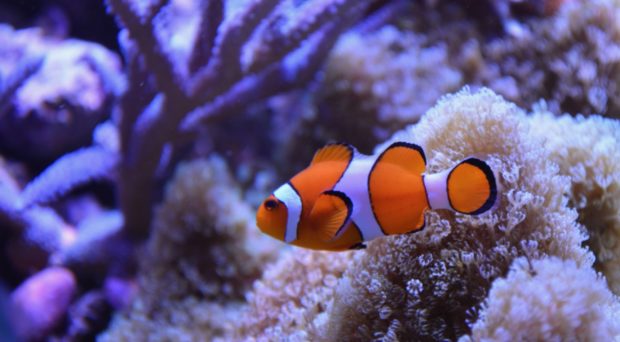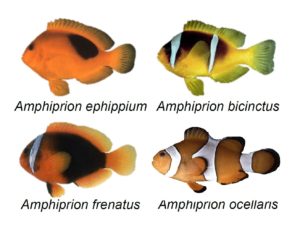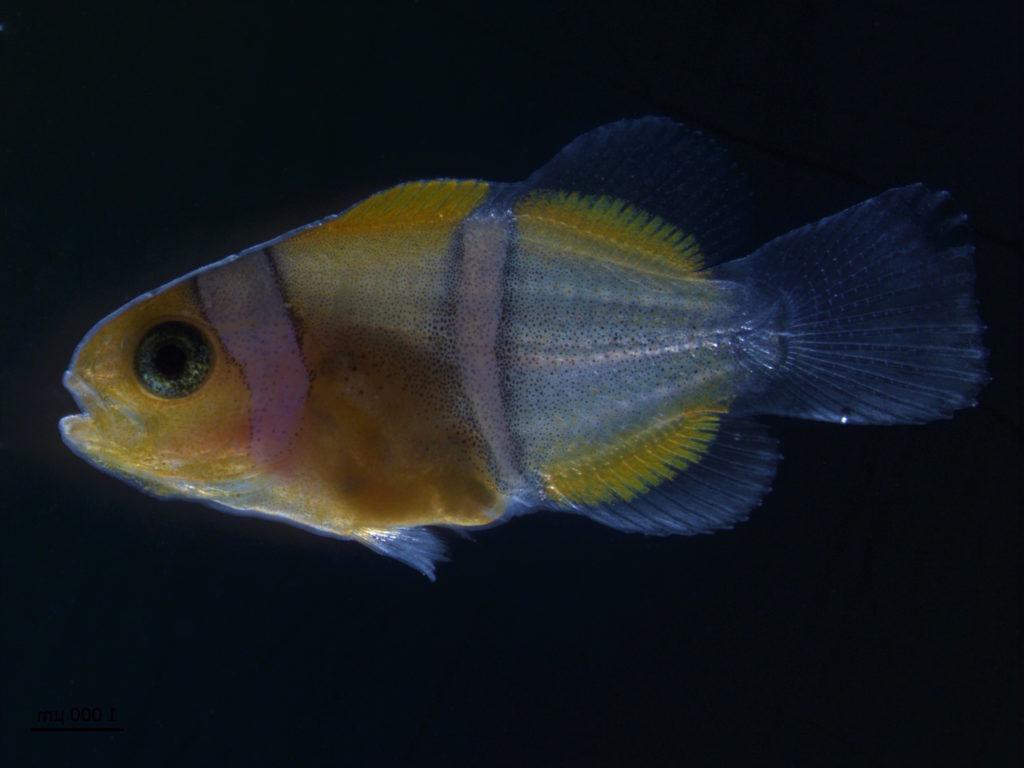
Marine tropical waters house beautifully colored fishes. In addition to the diversity of colors, these fish also display striking pigmentation such as spots, eyespots, stripes, repeated lines, and grids, which may play a role in species recognition, camouflage, mimicry or warning. While we are fascinated by these colors and patterns, how such diversity evolved is still understudied.
Clownfish, perhaps most famously represented by Nemo from the Disney Pixar films, represent a good model system to try to understand how color patterns evolve.
There are 30 different species of clownfish within the Pomacentridae family, which mainly differ in appearance by the number of white vertical stripes visible on their yellow to red, brown or even black body background.

In order to disentangle the factors governing the evolution of color patterns in coral reef fish, we needed a medium-sized monophyletic (descending from one common ancestor) clade, grouping species which differ in some simple color attribute, and for which we have a strong phylogenetic framework, i.e. strong hypotheses about the evolutionary relationships of the group of species. Clownfish phylogeny is well resolved and thus, they provided a good opportunity to question the diversification of white striped patterns.
Evolution of white stripe patterns in clownfishes
In our recent study to understand evolution of stripes, we classified every clownfish species according to their white stripe patterns at their adult stage – the number of stripes, and where they appear on the body. The combination of phylogenetic information with models of trait evolution revealed that the ancestor of extant clownfishes likely possessed three white stripes. Then, during the course of evolution, some species lost their stripes.
Evolutionary loss of white stripes is not random, but always occurs in a progressive and sequential order from tail to head
We found that the evolutionary loss of white stripes is not random. Instead, the losses of white stripes always occurred in a progressive and sequential fashion from caudal (“tail”) to rostral (“head”) regions. In species with two stripes it is always the stripe on the caudal peduncle – just before the tail – that has been lost, and the head and the trunk stripes are retained. All one-stripe species have lost the peduncle stripe and also the trunk-stripe, retaining only the head stripe.
Parallelism between evolution and development
To try to explain this evolutionary pattern, we adopted a perspective from Evolutionary Developmental Biology (“evo-devo”) and we studied the ontogeny (i.e. the developmental history of an organism) of white stripe patterns.
In recent decades, numerous studies have demonstrated that the origin of phenotypic diversity might be explained by the alteration of ontogenetic trajectories, whereby the reasons behind individual pattern formation might be similar across evolutionary time, We thus hypothesized that such a variation may underpin the diversification of white stripes in clownfishes.

Interestingly, every clownfish species has three white stripes at the transition between larval and juvenile stages, regardless of how many stripes the adult ends up with. During this first part of the development, the gain of stripes is from rostral to caudal regions. Then, in clownfish species showing less than three stripes at the adult stage, we observed a sequential caudo-rostral loss of stripes – similar to the one observed during evolution.
These results suggest that the evolution of white stripes in clownfishes is constrained by developmental processes.
What is the role of the white stripe pattern?
Color patterns may play a numerous roles, especially in coral reef environments where there are many interactions among species and individuals. So, in the last part of our paper published in BMC Biology, we tested various hypotheses about the factors acting on the selection of stripe pattern.
By comparing the diversity of white striped patterns observed in a community of clownfishes from the same region with random simulated communities, we found that the number of species pairs showing the same striped pattern is exceptionally low in natural communities compared with simulated ones. These results suggested that white stripes are used for signaling between species, and social selection on visual signals probably operates on the phenotypic divergence of clownfishes.
Unraveling the mysteries of why pigmentation patterns from coral reef fish are so diverse, how these evolved, and how this diversity originated will help us to understand the formation of very complex phenotypes. Our study will certainly be challenged and complemented by further research and that will help to answer the remaining questions regarding how diversity is produced.
Pauline Salis, Bruno Frédérich & Vincent Laudet
Bruno is fascinated by the beauty of tropical marine waters and started to take an interest in coral reef fish from the age of 12. After a Ph.D. devoted to the ontogeny of damselfishes, he achieved post-docs during which he focused on the morphological evolution of coral reef fishes. Since March 2018, Bruno is developing his research group at the University of Liège (Belgium) where he aims to understand the factors governing diversity in space and time.
Originally a molecular biologist, Vincent started to work on the evolution of developmental mechanisms more than 20 years ago. He uses coral reef fish to study how hormones alter the life cycle of complex organisms in their natural environment. Such a research agenda, in the new field of Eco/Evo/Devo allows integration of knowledge gathered by different and complementary approaches in biology.
Latest posts by Pauline Salis, Bruno Frédérich & Vincent Laudet (see all)
- Evolution and development of white stripes in Nemo and his cousins - 5th September 2018
Comments